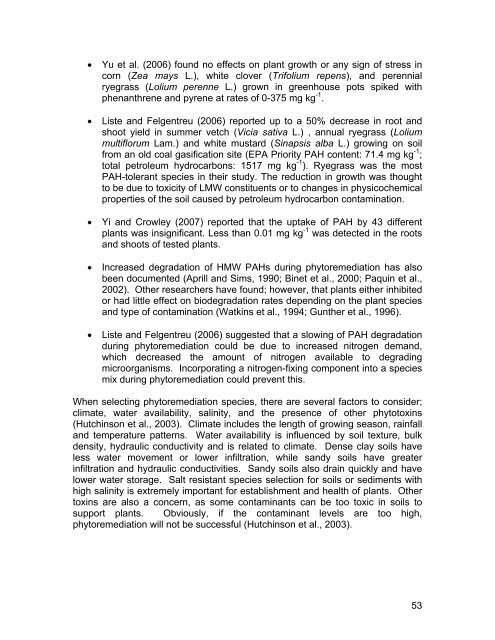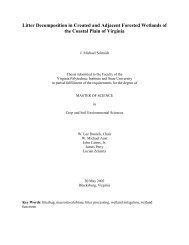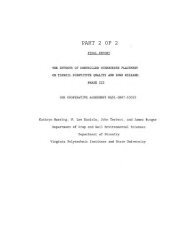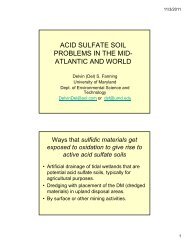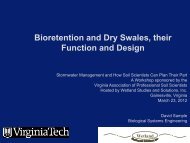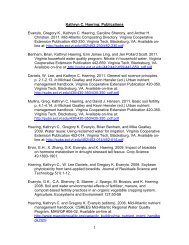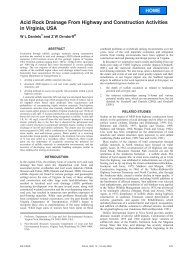Remediation of PAH-Contaminated Soils and Sediments: A ...
Remediation of PAH-Contaminated Soils and Sediments: A ...
Remediation of PAH-Contaminated Soils and Sediments: A ...
Create successful ePaper yourself
Turn your PDF publications into a flip-book with our unique Google optimized e-Paper software.
� Yu et al. (2006) found no effects on plant growth or any sign <strong>of</strong> stress in<br />
corn (Zea mays L.), white clover (Trifolium repens), <strong>and</strong> perennial<br />
ryegrass (Lolium perenne L.) grown in greenhouse pots spiked with<br />
phenanthrene <strong>and</strong> pyrene at rates <strong>of</strong> 0-375 mg kg -1 .<br />
� Liste <strong>and</strong> Felgentreu (2006) reported up to a 50% decrease in root <strong>and</strong><br />
shoot yield in summer vetch (Vicia sativa L.) , annual ryegrass (Lolium<br />
multiflorum Lam.) <strong>and</strong> white mustard (Sinapsis alba L.) growing on soil<br />
from an old coal gasification site (EPA Priority <strong>PAH</strong> content: 71.4 mg kg -1 ;<br />
total petroleum hydrocarbons: 1517 mg kg -1 ). Ryegrass was the most<br />
<strong>PAH</strong>-tolerant species in their study. The reduction in growth was thought<br />
to be due to toxicity <strong>of</strong> LMW constituents or to changes in physicochemical<br />
properties <strong>of</strong> the soil caused by petroleum hydrocarbon contamination.<br />
� Yi <strong>and</strong> Crowley (2007) reported that the uptake <strong>of</strong> <strong>PAH</strong> by 43 different<br />
plants was insignificant. Less than 0.01 mg kg -1 was detected in the roots<br />
<strong>and</strong> shoots <strong>of</strong> tested plants.<br />
� Increased degradation <strong>of</strong> HMW <strong>PAH</strong>s during phytoremediation has also<br />
been documented (Aprill <strong>and</strong> Sims, 1990; Binet et al., 2000; Paquin et al.,<br />
2002). Other researchers have found; however, that plants either inhibited<br />
or had little effect on biodegradation rates depending on the plant species<br />
<strong>and</strong> type <strong>of</strong> contamination (Watkins et al., 1994; Gunther et al., 1996).<br />
� Liste <strong>and</strong> Felgentreu (2006) suggested that a slowing <strong>of</strong> <strong>PAH</strong> degradation<br />
during phytoremediation could be due to increased nitrogen dem<strong>and</strong>,<br />
which decreased the amount <strong>of</strong> nitrogen available to degrading<br />
microorganisms. Incorporating a nitrogen-fixing component into a species<br />
mix during phytoremediation could prevent this.<br />
When selecting phytoremediation species, there are several factors to consider;<br />
climate, water availability, salinity, <strong>and</strong> the presence <strong>of</strong> other phytotoxins<br />
(Hutchinson et al., 2003). Climate includes the length <strong>of</strong> growing season, rainfall<br />
<strong>and</strong> temperature patterns. Water availability is influenced by soil texture, bulk<br />
density, hydraulic conductivity <strong>and</strong> is related to climate. Dense clay soils have<br />
less water movement or lower infiltration, while s<strong>and</strong>y soils have greater<br />
infiltration <strong>and</strong> hydraulic conductivities. S<strong>and</strong>y soils also drain quickly <strong>and</strong> have<br />
lower water storage. Salt resistant species selection for soils or sediments with<br />
high salinity is extremely important for establishment <strong>and</strong> health <strong>of</strong> plants. Other<br />
toxins are also a concern, as some contaminants can be too toxic in soils to<br />
support plants. Obviously, if the contaminant levels are too high,<br />
phytoremediation will not be successful (Hutchinson et al., 2003).<br />
53


